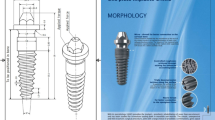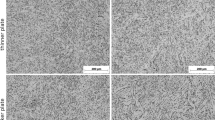Abstract
The aim of this study was to fully characterize the mechanical behavior of an external hexagonal implant connection (ø3.5 mm, 10-mm length) with an in vitro study, a three-dimensional finite element analysis, and a probabilistic fatigue study. Ten implant-abutment assemblies were randomly divided into two groups, five were subjected to a fracture test to obtain the maximum fracture load, and the remaining were exposed to a fatigue test with 360,000 cycles of 150 ± 10 N. After mechanical cycling, all samples were attached to the torque-testing machine and the removal torque was measured in Newton centimeters. A finite element analysis (FEA) was then executed in ANSYS® to verify all results obtained in the mechanical tests. Finally, due to the randomness of the fatigue phenomenon, a probabilistic fatigue model was computed to obtain the probability of failure associated with each cycle load. FEA demonstrated that the fracture corresponded with a maximum stress of 2454 MPa obtained in the in vitro fracture test. Mean life was verified by the three methods. Results obtained by the FEA, the in vitro test, and the probabilistic approaches were in accordance. Under these conditions, no mechanical etiology failure is expected to occur up to 100,000 cycles.

ᅟ













Similar content being viewed by others
References
Kim SK, Lee JB, Koak JY et al (2005) An abutment screw loosening study of a diamond like carbon-coated CP titanium implant. J Oral Rehabil 32:346–350. https://doi.org/10.1111/j.1365-2842.2004.01475.x
Brandt W, Claro Neves A, de Lima AP et al (2013) Stability of external and internal implant connections after a fatigue test. Eur J Dent 7:267–271. https://doi.org/10.4103/1305-7456.115407
Cordeiro JM, Barão VAR (2017) Is there scientific evidence favoring the substitution of commercially pure titanium with titanium alloys for the manufacture of dental implants? Mater Sci Eng C 71:1201–1215. https://doi.org/10.1016/j.msec.2016.10.025
Prado AM, Pereira J, Silva FS, Henriques B, Nascimento RM, Benfatti CAM, López-López J, Souza JCM (2017) Wear of Morse taper and external hexagon implant joints after abutment removal. J Mater Sci Mater Med 28(5):65. https://doi.org/10.1007/s10856-017-5879-6
Coray R, Zeltner M, Özcan M (2016) Fracture strength of implant abutments after fatigue testing: a systematic review and a meta-analysis. J Mech Behav Biomed Mater 62:333–346. https://doi.org/10.1016/j.jmbbm.2016.05.011
Alqahtani F, Flinton R (2014) Postfatigue fracture resistance of modified prefabricated zirconia implant abutments. J Prosthet Dent 112:299–305. https://doi.org/10.1016/j.prosdent.2013.08.023
Rezende CEE, Chase-Diaz M, Costa MD, Albarracin ML, Paschoeto G, Sousa EAC, Rubo JH, Borges AFS (2015) Stress distribution in single dental implant system. J Craniofac Surg 26:2196–2200. https://doi.org/10.1097/SCS.0000000000001977
Moraes SLD, Verri FR, Júnior SJF et al (2018) Three-dimensional finite element analysis of varying diameter and connection type in implants swith high crown-implant ratio. Braz Dent J 29:36–42. https://doi.org/10.1590/0103-6440201801746
Solberg K, Heinemann F, Pellikaan P, Keilig L, Stark H, Bourauel C, Hasan I (2017) Finite element analysis of different loading conditions for implant-supported overdentures supported by conventional or mini implants. Comput Methods Biomech Biomed Engin 20:770–782. https://doi.org/10.1080/10255842.2017.1302432
ISO 14801:2007(E) (2007) Dentistry—implants—dynamic fatigue test for endosseous dental implants, 2nd edn
Gehrke SA, De Carvalho Serra R (2015) Load fatigue performance of conical implant-abutment connection: effect of torque level and interface junction. Minerva Stomatol 64:1–7
Lima de Andrade C, Carvalho M, Bordin D, da Silva W, del Bel Cury A, Sotto-Maior B (2017) Biomechanical behavior of the dental implant macrodesign. Int J Oral Maxillofac Implants 32:264–270. https://doi.org/10.11607/jomi.4797
Al-Otaibi HN, Almutairi A, Alfarraj J, Algesadi W (2017) The effect of torque application technique on screw preload of implant-supported prostheses. Int J Oral Maxillofac Implants 32:259–263. https://doi.org/10.11607/jomi.4773
Assunção WG, Delben JA, Tabata LF, Barão VAR, Gomes ÉA, Garcia IR Jr (2012) Preload evaluation of different screws in external hexagon joint. Implant Dent 21:46–50. https://doi.org/10.1097/ID.0b013e31823fcbce
Hoyer SA, Stanford CM, Buranadham S, Fridrich T, Wagner J, Gratton D (2001) Dynamic fatigue properties of the dental implant–abutment interface: joint opening in wide-diameter versus standard-diameter hex-type implants. J Prosthet Dent 85:599–607. https://doi.org/10.1067/mpr.2001.115250
Breeding LC, Dixon DL, Nelson EW, Tietge JD (1993) Torque required to loosen single-tooth implant abutment screws before and after simulated function. Int J Prosthodont 6:435–439
Gehrke SA, Poncio da Silva PM, Calvo Guirado JL, Delgado-Ruiz RA, Dedavid BA, Aline Nagasawa M, Shibli JA (2016) Mechanical behavior of zirconia and titanium abutments before and after cyclic load application. J Prosthet Dent 116:529–535. https://doi.org/10.1016/j.prosdent.2016.02.015
Freitas-Júnior AC, Rocha EP, Bonfante EA, Almeida EO, Anchieta RB, Martini AP, Assunção WG, Silva NRFA, Coelho PG (2012) Biomechanical evaluation of internal and external hexagon platform switched implant-abutment connections: an in vitro laboratory and three-dimensional finite element analysis. Dent Mater 28:e218–e228. https://doi.org/10.1016/j.dental.2012.05.004
Pérez MA, Prados-Frutos JC, Bea JA, Doblaré M (2012) Stress transfer properties of different commercial dental implants: a finite element study. Comput Methods Biomech Biomed Engin 15:263–273. https://doi.org/10.1080/10255842.2010.527834
Bacchi A, Consani RLX, Mesquita MF, dos Santos MBF (2013) Stress distribution in fixed-partial prosthesis and peri-implant bone tissue with different framework materials and vertical misfit levels: a three-dimensional finite element analysis. J Oral Sci 55:239–244
Peixoto HE, Bordin D, Del Bel Cury AA et al (2016) The role of prosthetic abutment material on the stress distribution in a maxillary single implant-supported fixed prosthesis. Mater Sci Eng C 65:90–96. https://doi.org/10.1016/j.msec.2016.04.004
Bea JA, Doblaré M (2002) Enhanced B-PFEM model for fatigue life prediction of metals during crack propagation. Comput Mater Sci 25:14–33. https://doi.org/10.1016/S0927-0256(02)00246-X
Anderson TL (1995) Fracture mechanics: fundamentals and applications. CRC Press, Boca Ratón, Florida
Madsen HO, Krenk S, Lind NC (1986) Methods of structural safety. Prentice-Hall, Englewood Cliffs, New Jersey
Prados-Privado M, Prados-Frutos J, Calvo-Guirado J, Bea J (2016) A random fatigue of mechanize titanium abutment studied with Markoff chain and stochastic finite element formulation. Comput Methods Biomech Biomed Engin 19:1583–1591. https://doi.org/10.1080/10255842.2016.1170124
Sridhar S, Wilson TG Jr, Palmer KL, Valderrama P, Mathew MT, Prasad S, Jacobs M, Gindri IM, Rodrigues DC (2015) In vitro investigation of the effect of oral bacteria in the surface oxidation of dental implants. Clin Implant Dent Relat Res 17:e562–e575. https://doi.org/10.1111/cid.12285
Guindy JS, Schiel H, Schmidli F, Wirz J (2004) Corrosion at the marginal gap of implant-supported suprastructures and implant failure. Int J Oral Maxillofac Implants 19:826–831
Gupta S, Gupta H, Tandan A (2015) Technical complications of implant-causes and management: a comprehensive review. Natl J Maxillofac Surg 6:3–8. https://doi.org/10.4103/0975-5950.168233
Piattelli A, Scarano A, Piattelli M, Vaia E, Matarasso S (1998) Hollow implants retrieved for fracture: a light and scanning electron microscope analysis of 4 cases. J Periodontol 69:185–189. https://doi.org/10.1902/jop.1998.69.2.185
Tolman DE, Laney WR (1992) Tissue-integrated prosthesis complications. Int J Oral Maxillofac Implants 7:477–484. https://doi.org/10.1097/00008505-199309000-00018
Marchetti E, Ratta S, Mummolo S, Tecco S, Pecci R, Bedini R, Marzo G (2016) Mechanical reliability evaluation of an oral implant-abutment system according to UNI EN ISO 14801 fatigue test protocol. Implant Dent 25:613–618. https://doi.org/10.1097/ID.0000000000000453
Park S-J, Lee S-W, Leesungbok R, Ahn S-J (2016) Influence of the connection design and titanium grades of the implant complex on resistance under static loading. J Adv Prosthodont 8:388–395. https://doi.org/10.4047/jap.2016.8.5.388
Alsahhaf A, Spies BC, Vach K, Kohal R-J (2017) Fracture resistance of zirconia-based implant abutments after artificial long-term aging. J Mech Behav Biomed Mater 66:224–232. https://doi.org/10.1016/j.jmbbm.2016.11.018
Patankar A, Kheur M, Kheur S, Lakha T, Burhanpurwala M (2016) Fracture resistance of implant abutments following abutment alterations by milling the margins: an in vitro study. J Oral Implantol 42:464–468. https://doi.org/10.1563/aaid-joi-D-16-00010
Takata H, Komine F, Honda J, Blatz M, Matsumura H (2018) An in vitro evaluation of fracture load of implant-supported zirconia-based prostheses fabricated with different veneer materials. Clin Oral Implants Res 29:396–403. https://doi.org/10.1111/clr.13135
Chrcanovic BR, Kisch J, Albrektsson T, Wennerberg A (2018) Factors influencing the fracture of dental implants. Clin Implant Dent Relat Res 20:58–67. https://doi.org/10.1111/cid.12572
Tagger Green N, Machtei EE, Horwitz J, Peled M (2002) Fracture of dental implants: literature review and report of a case. Implant Dent 11:137–143
Amid R, Raoofi S, Kadkhodazadeh M, Movahhedi MR, Khademi M (2013) Effect of microthread design of dental implants on stress and strain patterns: a three-dimensional finite element analysis. Biomed Tech (Berl) 58:457–467. https://doi.org/10.1515/bmt-2012-0108
Chowdhary R, Halldin A, Jimbo R, Wennerberg A (2015) Influence of micro threads alteration on osseointegration and primary stability of implants: an FEA and in vivo analysis in rabbits. Clin Implant Dent Relat Res 17:562–569. https://doi.org/10.1111/cid.12143
Pekta O, Tonuk E (2014) Mechanical design, analysis, and laboratory testing of a dental implant with axial flexibility similar to natural tooth with periodontal ligament. Proc Inst Mech Eng Part H J Eng Med 228:1117–1125. https://doi.org/10.1177/0954411914557713
Wang K, Geng J, Jones D, Xu W (2016) Comparison of the fracture resistance of dental implants with different abutment taper angles. Mater Sci Eng C 63:164–171. https://doi.org/10.1016/j.msec.2016.02.015
Shemtov-Yona K, Rittel D (2016) Fatigue of dental implants: facts and fallacies. Dent J 4:16. https://doi.org/10.3390/dj4020016
Baggi L, Cappelloni I, Maceri F, Vairo G (2008) Stress-based performance evaluation of osseointegrated dental implants by finite-element simulation. Simul Model Pract Theory 16:971–987. https://doi.org/10.1016/j.simpat.2008.05.009
Yamaguchi S, Yamanishi Y, Machado LS, Matsumoto S, Tovar N, Coelho PG, Thompson VP, Imazato S (2018) In vitro fatigue tests and in silico finite element analysis of dental implants with different fixture/abutment joint types using computer-aided design models. J Prosthodont Res 62:24–30. https://doi.org/10.1016/j.jpor.2017.03.006
Funding
This work was supported by the Grant A-285 (URJC—Proclinic, Principal Researcher JC Prados—Frutos).
Author information
Authors and Affiliations
Corresponding author
Ethics declarations
Conflict of interest
The authors declare that they have no conflict of interest.
Rights and permissions
About this article
Cite this article
Prados-Privado, M., Gehrke, S.A., Rojo, R. et al. Complete mechanical characterization of an external hexagonal implant connection: in vitro study, 3D FEM, and probabilistic fatigue. Med Biol Eng Comput 56, 2233–2244 (2018). https://doi.org/10.1007/s11517-018-1846-8
Received:
Accepted:
Published:
Issue Date:
DOI: https://doi.org/10.1007/s11517-018-1846-8




